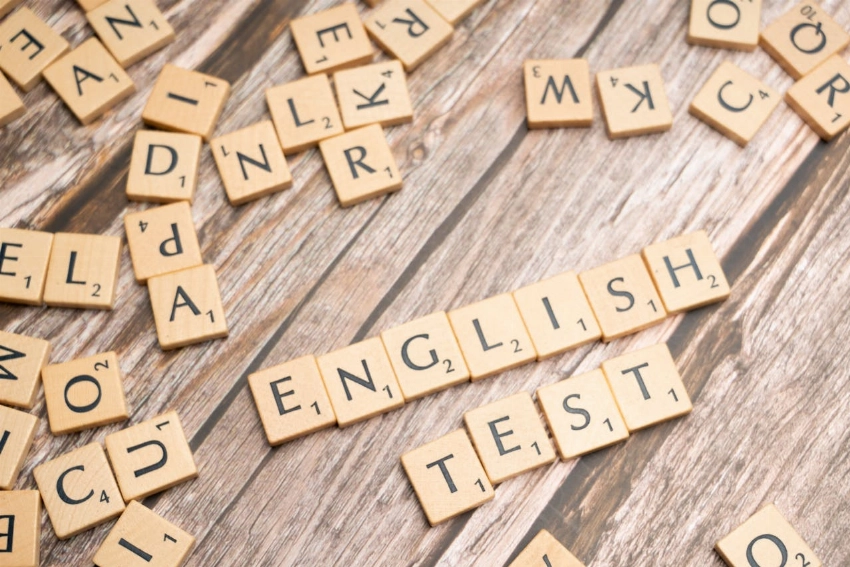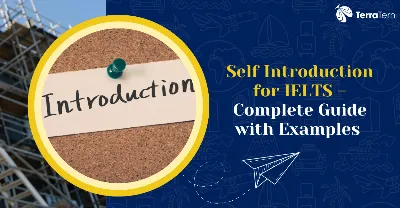Key Highlights
- Why Is Self Introduction for IELTS Important in Speaking in 2025?
- Self Introduction for IELTS Structure in 2025 (Step-by-Step)
- Self introduction Example for IELTS (Band 7+): Updated 2025
- Common Mistakes in the Introduction of Myself in IELTS in 2025
- How to Personalise Your Self introduction for IELTS: Latest Guide 2025
- Tell Me About Yourself IELTS Sample Answer (With Analysis): 2025 Tips
- Tips to Impress the Examiner in Self Introduction for IELTS in 2025
- Latest Changes and Trends in Self Introduction for IELTS Speaking (2025)
- Conclusion:
Self introduction for IELTS is an essential aspect of the IELTS Speaking Part 1, which establishes the atmosphere and leaves a first impression. The IELTS format in 2025 concentrates less on grammar and unnatural, stilted speech, and the candidates gain rewards when they sound boisterous and real. Examiners have now shifted their reference from spontaneous responses to memorised ones. This includes using personal stories, different vocabulary, and conversational introductions, found among high English language proficiency test scores, especially those seeking Band 7+. The question "Tell me about yourself" remains the most common in Part 1, making preparation essential.
Indian and Southeast Asian candidates are also getting better results when speaking with the help of a more efficient self introduction for IELTS strategy. As increasing numbers of online and video-based IELTS tests are run, the introduction has become more critical than ever before. However, most would lose marks, act like robots or be too rehearsed. The query of the self introduction for IELTS example in the IELTS has exploded in the year 2025, which indicates the increased desire to know what the professionals suggest. The guide includes new structures, examples of mistakes, model answers and effective techniques that will help you impress the examiner and improve your mark.
Why Is Self Introduction for IELTS Important in Speaking in 2025?

Here are a few primary reasons of why self introduction for IELTS is essential in speaking:
-
The impression is determined by the test's initial several seconds.
-
A good self introduction for IELTS reflects fluent and confident usage at once.
-
Immediately, examiners start evaluating pronunciation, grammar and vocabulary.
-
Your initial impression can determine whether you can achieve a Band 7 and above.
-
Talking about yourself challenges you in dealing with certain familiar things.
-
With a good introduction, Parts 2 and 3 of the Speaking test are in a good rhythm.
-
Examiners learn to look at natural delivery, not memorised.
-
Starting well allows one to eliminate nervousness and elevate performance.
-
More than 65 per cent of high scorers state that they perfected their introduction during the preparation.
Also Read: IELTS Speaking Topics with Answers: Experts’ New Guide
Self Introduction for IELTS Structure in 2025 (Step-by-Step)
Here is a self introduction for IELTS step-by-step structure:
Greetings and Name
The self introduction for IELTS starts with greetings and a name:
-
Start it with a natural, but polite greeting.
-
E.g. Good morning. I am called Aakash.”
-
Be friendly and use a clear tone.
-
When speaking face-to-face, look at them.
-
Do not sound like a robot; do not pause.
Biography and Birthplace
The self introduction for IELTS is then followed by a biography and birthplace:
-
At least mention our origin in one or two lines.
-
An example is: I am Jaipurian. It is an ancient city in the north of India.
-
Include one interesting or unusual fact about your hometown.
-
It should not be long and irrelevant.
Education or Occupation
Education and Occupation come next in the self introduction for IELTS :
-
Write what your profession is (what you are studying or doing).
-
Example: I am a master's student in computer science
-
Or: I am a digital marketing executive in a start-up firm.
-
Add one positive or interesting thing, including a project or an interest.
-
Be brief and stay away from technical terms.
Interests and Hobbies
Interests and Hobbies follow later in the self introduction for IELTS :
-
Speak about 1 2 hobbies which are characteristic of your personality.
-
Case: I like to read mystery books during my leisure time.
-
Or, I like playing badminton and going to the cafes.
-
Consistency with the use of the present tense.
-
Talk usually, and as though you were conversing with a friend.
Future Goals
A self introduction for IELTS is usually wrapped up by explaining one’s future goals:
-
In a sentence or so, state why you undertook the IELTS test.
-
For example, I intend to pursue higher studies in Canada.
-
Or: I want to go unless I want to work in a foreign country and develop my international career.
-
Stay authentic and concentrated in your tone.
-
Stay away from vague and clichéd words such as to enrich my life.
Also Read: IELTS Exam Syllabus: Latest Exam Guide & Updates
Self introduction Example for IELTS (Band 7+): Updated 2025

Here is are self introduction example for IELTS to get a band score of 7+:
Beginner Level Example
Here is a beginner level self introduction example for IELTS:
-
"Hello. My name is Priya."
-
"I am from Mumbai, India."
-
"I study in college, in my second year."
-
"I like to dance and watch movies in my free time."
-
"I want to go to Australia to further my studies."
Intermediate Level Example
Here is an intermediate level self introduction example for IELTS:
-
"Hi. I’m Rohan, and I’m from Delhi."
-
"I recently graduated with a degree in Commerce."
-
"Right now, I’m preparing for my MBA entrance exams."
-
"In my free time, I enjoy listening to music and travelling to new places."
-
"I’m taking the IELTS to apply for universities in the UK."
Advanced Level Example (Band 7+)
Here is an advanced level self introduction example for IELTS:
-
"Good morning. My name is Neha, and I’m from Pune, India."
-
"I’ve recently completed my Bachelor’s in Architecture."
-
"I’m currently working as an intern at a green building design firm."
-
"I’m passionate about sustainable architecture and eco-friendly housing."
-
"In my free time, I enjoy painting, hiking, and reading historical fiction."
-
"I’m taking the IELTS to apply for a Master’s program in the Netherlands."
Common Mistakes in the Introduction of Myself in IELTS in 2025
Here are some common mistakes one can make in the introduction of myself in IELTS along with answers:
-
When answering word by word, you sound like an android.
-
Fix: Work out the wayward variants of your introduction to sound like yourself.
-
Not being clear or detailed enough will only confuse the examiner, undermining your strength.
-
Fix: Set up to 4-6 clear and pertinent sentences.
-
Score affects when you use incorrect grammar or a change of tenses.
-
Excerpt: Pay attention to using the present tense with easy, correct sentence formations.
-
Speaking slowly or quickly reduces fluency and makes it difficult to understand.
-
Fix: train to speak relatively slowly but comfortably in a natural Pause.
-
Strength of filler words, such as using umm,"r like or you know diminishes clarity and fluency.
-
Fix: Pause rather than filling to be in control.
-
Not answering why you're taking the IELTS makes your response incomplete.
-
Fix: Give an idea of a specific aim, such as studying or working in another country.
Working with these fixes for the common mistakes for introducing myself in IELTS can be very beneficial
Also Read: IELTS Band Score Table: New Academic & Listening Guide
How to Personalise Your Self introduction for IELTS: Latest Guide 2025

Here is a quick guide on how to personalise your self introduction for IELTS:
-
Put something special on it so it does not look like the rest.
-
For example, I assist rescue organisations for stray animals in my town.
-
Do not use a ready-made answer; I am a hardworking hackneyed individual.
-
Instead, use examples of life to demonstrate qualities.
-
Examples: I combine complete time work with courses at weekends (in graphic design).
-
Write naturally, in the manner that you feel comfortable with.
-
Speak casually and formally as you would in a friendly, formal conversation.
-
Make your introduction true and real.
-
Examiners are known to compensate for natural performance and honest answers.
-
Repeat your introduction to practice out loud.
-
This assists in snapping up clumsy wordings and develops fluency.
-
Tape-record and playback.
-
Check your tone, clarity, pronunciation, and word selection
Tell Me About Yourself IELTS Sample Answer (With Analysis): 2025 Tips
Here’s an example with analysis of the Tell me about yourself IELTS sample answer:
Sample Answer (Band 7.5)
Here is a band 7.5 worth telling me about yourself, IELTS sample answer:
-
"Good afternoon. I’m Aditi, originally from Chandigarh."
-
"I hold a Bachelor’s in Mass Communication and currently work as a content strategist."
-
"I love crafting brand stories and managing social media campaigns."
-
"In my spare time, I enjoy photography and blogging about travel."
-
"I’m preparing for IELTS to apply for a postgraduate diploma in New Zealand."
Why It Works?
This is why these tips for the tell me about yourself IELTS sample answer work:
-
Has a concise pattern: name, background, job, hobby, and IELTS aim.
-
The tone flows very smoothly, naturally and confidently.
-
It features sophisticated words such as content strategist and the creation of brand stories.
-
Displays integration and sense in sentences.
-
Sounds intimate and natural, not rehearsed or mechanical.
Also Read: Is IELTS Difficult? New Insights, Tips & Strategies
Tips to Impress the Examiner in Self Introduction for IELTS in 2025

Here are some tips to impress your examiner with your self introduction for IELTS :
-
Be confident but friendly, and make natural eye contact by smiling.
-
Be slow and steady by using a controlled tone to display confidence.
-
You do not have to hurry up, speak comfortably and usually slowly; it is also essential to be fluent.
-
Use simple words even when unsure how to pronounce the complex words.
-
Smooth transitions should be made using such linking words as currently, initially, and also.
-
Avoid being robotised by saying something like My name is XYZ. I am an ABC.”
-
Use life experiences or some distinct features with your answers.
-
Your introduction must be short- 4-6 substantive sentences are perfect.
-
Regular practice tests should be conducted using mock speaking tests of the IELTS style.
-
Hear your voice and correct it to make it sound better and clearer with the proper pronunciation.
Latest Changes and Trends in Self Introduction for IELTS Speaking (2025)
Here is a list of the latest trends and changes surrounding self introduction for IELTS in 2025:
-
The responses concerning speaking are more concentrated on fluent delivery and originality.
-
Examiners are demanding increasingly personal and ad-lib introductions.
-
Some speaking topics people speak about are hobbies, web habits, travelling and social life.
-
IELTS in the form of online and take-home tests have grown popular.
-
A lot of candidates are currently taking the Speaking test through video connections.
-
A practical self-introduction for IELTS is even more critical in such digital media.
-
Answers that are rehearsed or memorised are examined to uncover.
-
Speaking Part 1 will always start with the notorious, classic, Tell me about yourself.
-
Having authentic patterns of speech can result in increased scores of fluency and coherence.
-
Idioms, transitions, and vocabulary exclusive to the topic come naturally to Band 7+ candidates.
Also Read: IELTS Exam Full Form: New Guide, Facts & How to Fill the Form?
Conclusion:
A good self introduction for IELTS may raise your IELTS speaking score by providing a good and strong start to the exam, impressing the examiner, and gaining confidence. To implement this, use a definite and sequential pattern that enlists your name, background, interests and goals. Speak your introduction out loud and over and over again: this will create some fluency, help to modify your pronunciation, and diminish your hesitancy. Since examiners assess conversational English, do not let the sound be mechanical or too practised. You should not just take general reactions, but tailor them with personal and real information about yourself. Assign your deliveries to the current expectations of the examiner 2025, which are directed to authenticity and coherence. Above all, remain composed and speak with authority. Always remember that it is only once that you can leave a great first impression, and when you have this chance, make the most of it. Contact TerraTern for more information!






